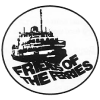
Behind the Scenes with Birkenhead Corporation's Ferry Orders
My father, Charles McRonald, was Chairman of Birkenhead’s Municipal Transport Committee at the time when the orders for the three new ferries (Mountwood, Woodchurch and Overchurch) were placed in the late 1950s. As a result, I was privy to some of the “behind the scenes” events.
In the mid-1950s, Birkenhead Corporation owned 4 coal-fired steam ferries: Hinderton (1925), Thurstaston (1930), Claughton (1930) and Bidston (1933), all built at Birkenhead by Cammell Laird. With increasing age, their maintenance costs were rising, although these had been contained by closing the ferry’s own maintenance department and entrusting repairs and overhauls to local ship repairers. All four ferries were from a similar era, but Hinderton was significantly older than the other three, and her replacement was clearly rather more urgent.



